edited by Filip Stabrowski and Liena Vayzman
Authors: Soheila Adl, Sherouk Alzeory, Habiba Boumlik, Marina Dedlovskaya, Lucia Fuentes, Marta Kowalczyk, Malgorzata Marciniak, Maureen Miller, Indira Persaud, Ashvini Persaud, Hanqi Ye, and Asel Zhetigenova.
One of the great privileges of teaching at an institution like LaGuardia is the opportunity for engaging with the rich diversity of our community. Learning about our faculty, staff, and students’ histories and experiences is an important part of the learning process itself. This collection of essays and photos about wedding traditions contributed by LaGuardia’s faculty, staff, and students is illustrative of this dynamic. Drawn from their direct knowledge and experiences, this selection of essays explores traditional practices, rituals, and beliefs – and the meanings behind them. Collectively, they weave a wonderful tapestry depicting the variety of ways of thinking about, representing, and performing wedding rituals. Ranging from Central America, to Europe (Western and Eastern), to Northern Africa, and Asia (Central and Eastern), this collection reflects the extraordinary diversity of our LaGuardia community. The essays show that cultural practices such as wedding traditions are not only learned and taught across the generations but are also dynamic and always changing. Negotiating this relationship between continuity and change, the traditional and the modern, is how cultures persist over time. Research into and engagement with wedding rituals remind us that cultures are not simply storehouses of shared practices and beliefs but evolving social formations with one foot planted in the past and the other moving forward into the future.
Filip Stabrowski, Associate Professor, Social Science
Liena Vayzman, Associate Professor, Humanities
by Ashvini and Indira Persaud
Guyana, South America has wedding traditions of people hailing from pre-partition India, Africa, Mongolia, Europe and China. Christian, Hindu, Catholic, Islamic and few other wedding practices are practiced in various households.
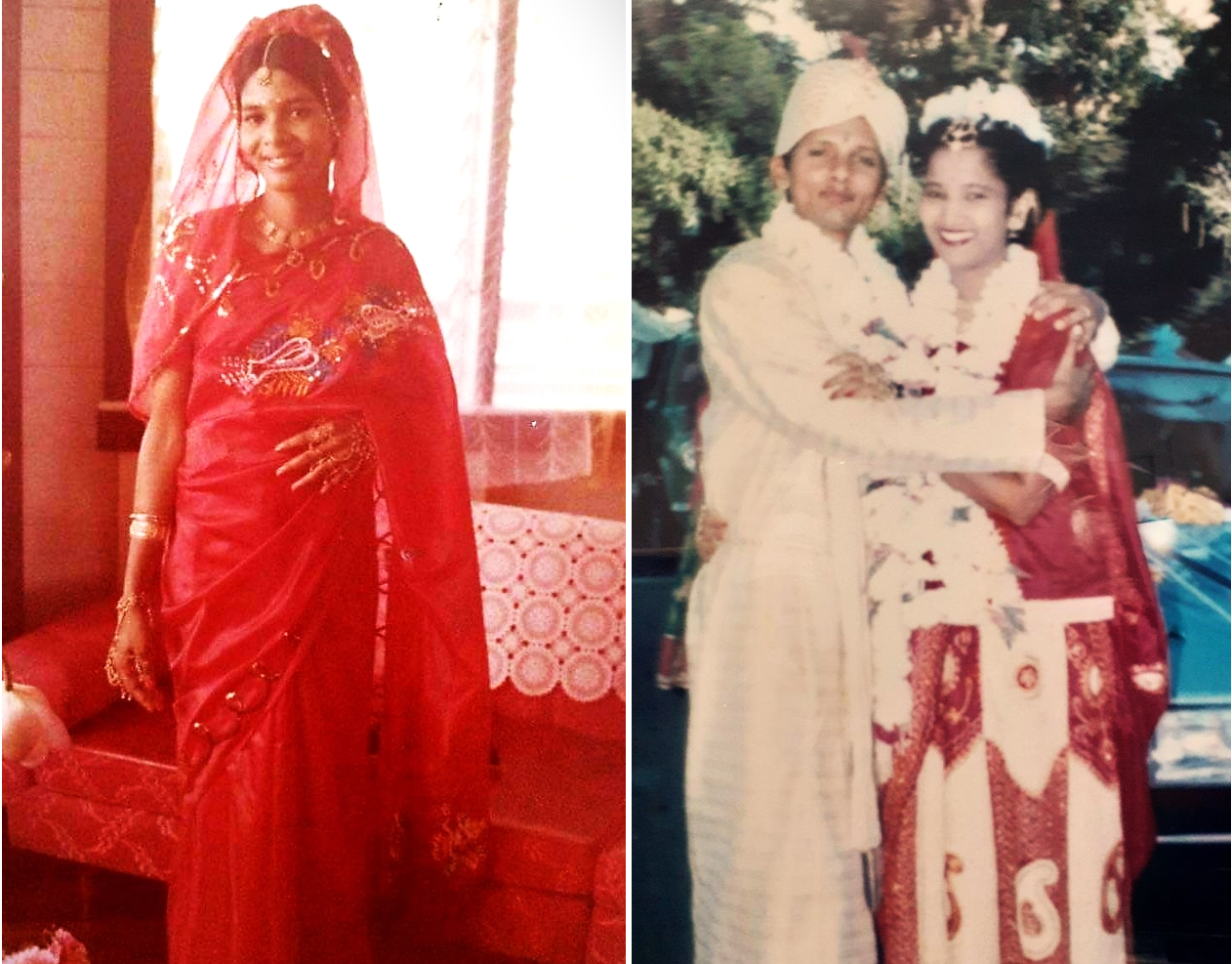
Left photo: Indira Persaud, a Hindu bride of Annandale. Groom hailed from Mahaicony. Sari was designed by P. Bissoondial, village wedding designer, whose vintage wedding sari is documented. Right photo: Sarvanand Bissondial, a practicing Hindu pandit, performing Hindu wedding ceremonies and poojas. He is 4th generation descendant of Indian & Guyanese Hindu leader/pandit, Bechu Sukul Maharaj of India & Guyana. He wore Sherwani & his bride, Lehengha. Photo credit: I.Persaud's personal photo archive.
Hindu weddings in Guyana can last as long as two weeks. These rituals include “Dig Dutty Night”, which includes two day rituals where pooja items are placed in the soil, dye rubbing, live tassa drumming, dancing and heavy outdoor cooking. Matikor tradition with seven steps rituals are part of the ceremonies. The bride is traditionally taken to the groom’s home on the second Sunday. These customs are from Sanatan Dharam and Arya Samaj traditions of India.
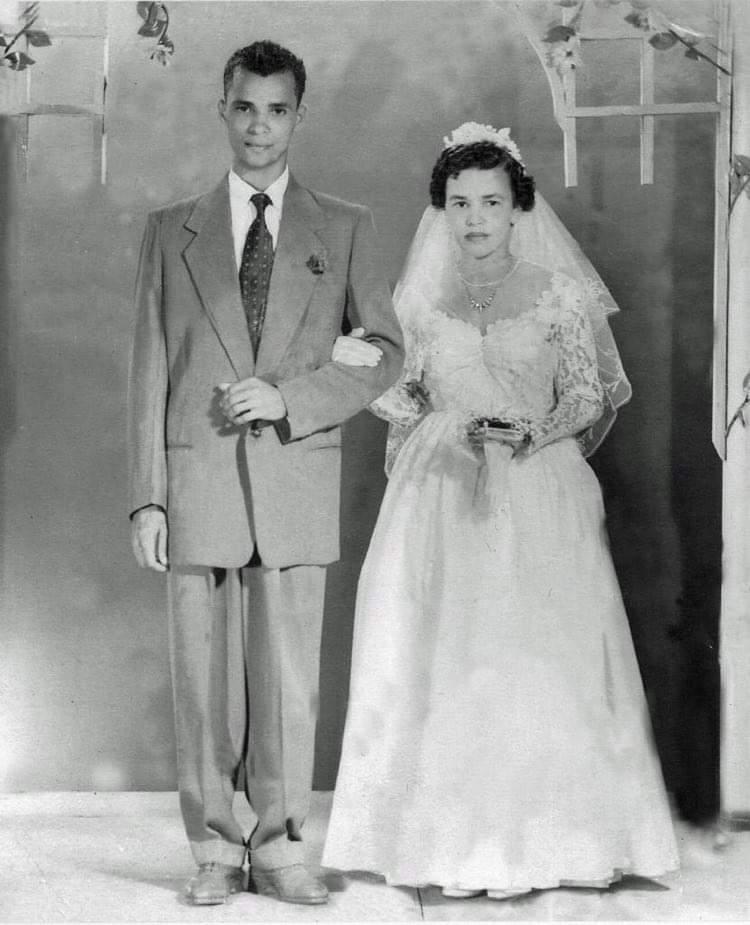
When the Europeans arrived to Guyana Christianity and Catholic wedding rituals persisted. Photo of the De Agrellas, decendents of Portugal and Africa.
Traditionally, a red saree is worn by Hindu bride, while mothers of Dulhin and Dulhan typically wear yellow sarees. Lehengha is a second option traditionally for the bride. There have been exceptions in colors of wedding outfits out of scarcity of saree in earlier generations. Styles and apparel traditionally worn have adapted more in wedding photos with access to broader Indian collections. Little Guyana, Richmond Hill wedding photos will show more access to apparel and saree options. Lending and regifting of saree to future Hindu brides is common practice in households and villages in Guyana. One of the oldest unusual white wedding sarees of Guyana is 72 and of former Guyanese wedding designer (90) of Lusignan, Victoria Village and Annandale, Guyana.
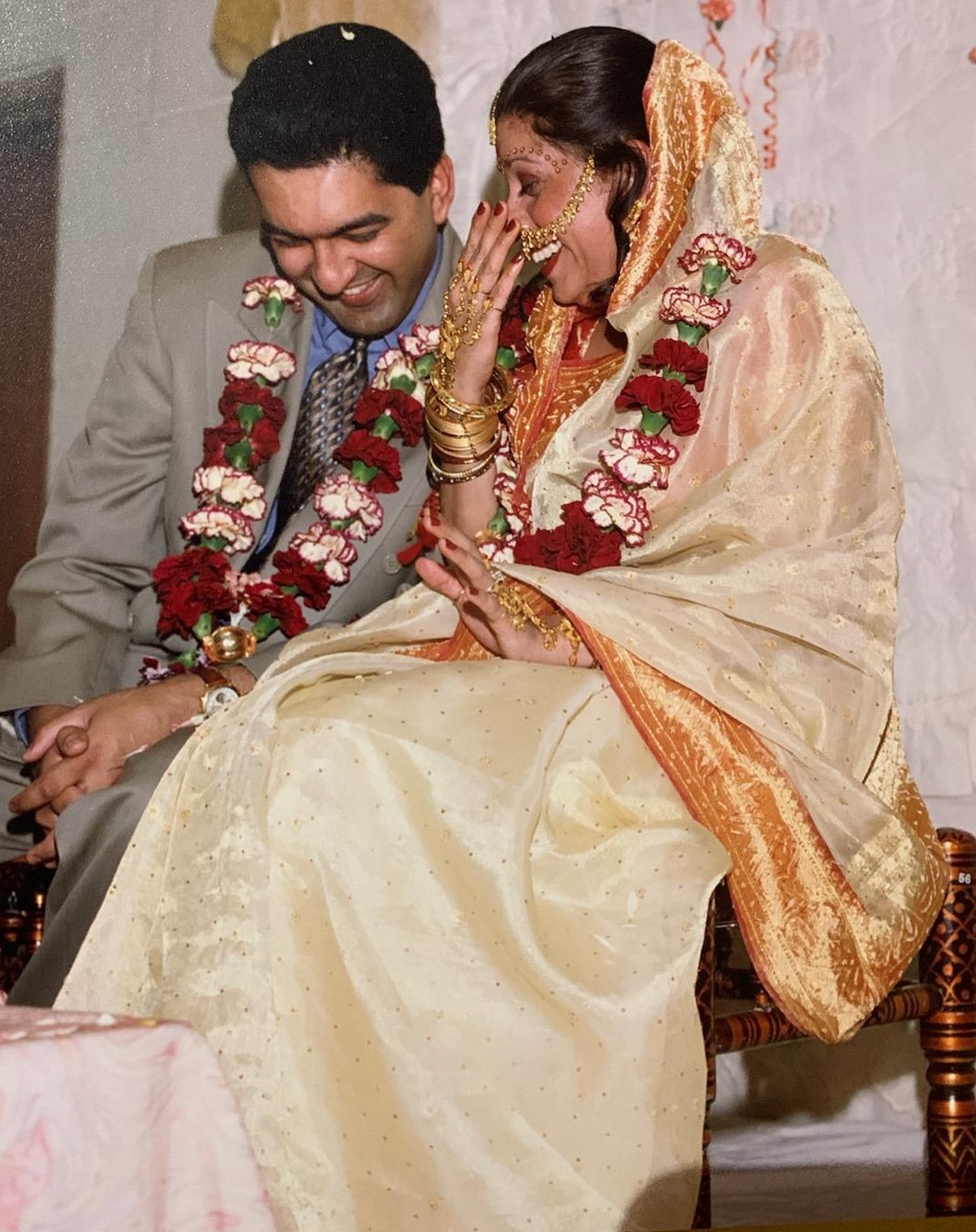
R. Ally, with roots to Guyana and Jamaica, is a Muslim groom with bride of Trinidadian Hindu background. Trinidad and Jamaica have similar Hindu and Muslim wedding traditions as do Guyanese dating back to Indentureship voyages of East Indians to the Caribbean and South America.
It is not unusual for Hindu and Muslim brides to change into a white wedding gown afterwards as Christian brides do, an add-on custom influenced by Europe. Michelle Cole, Roger Gary and Randy Madray are a few known Guyanese designers who have followed Guyanese wedding gown customs, and for those yearning sustainable wedding fabrics made of the diverse culture of Guyana, they can be found in pop up exhibits by Green Fad Museum.
Photos by International Museum of The Saree and Green Fad Museum.
by Ashvini and Indira Persaud
Fashion: a red or pink saree is a traditional and ancient identifying wedding apparel of women of South Asian and the continent's diaspora and are also worn at weddings in Nepal, Bangladesh, Sri Lanka, Indonesia, Singapore, Srilanka, Pakistan, Europe, Africa, Caribbean, South America - parts of the world where largely Hindu, Christian and Muslim wedding customs are practiced. The iconic saree has been interchanged often times at Hindu, Muslim and Christian weddings with the Lehengha (a long skirt and chuni top) and/or glittery Salwar Kameez Dupatta. There may be several apparel changes during the course of these multi-day weddings. The quality and style of these apparel vary by state and often times may differ with religious and social class. Most brides choose red or pink colors in Hindu weddings, while white sari can be found at Indian Christian weddings. There is excessive Indian jewelry adorning the outfits, hand and face of the brides which compliments henna.
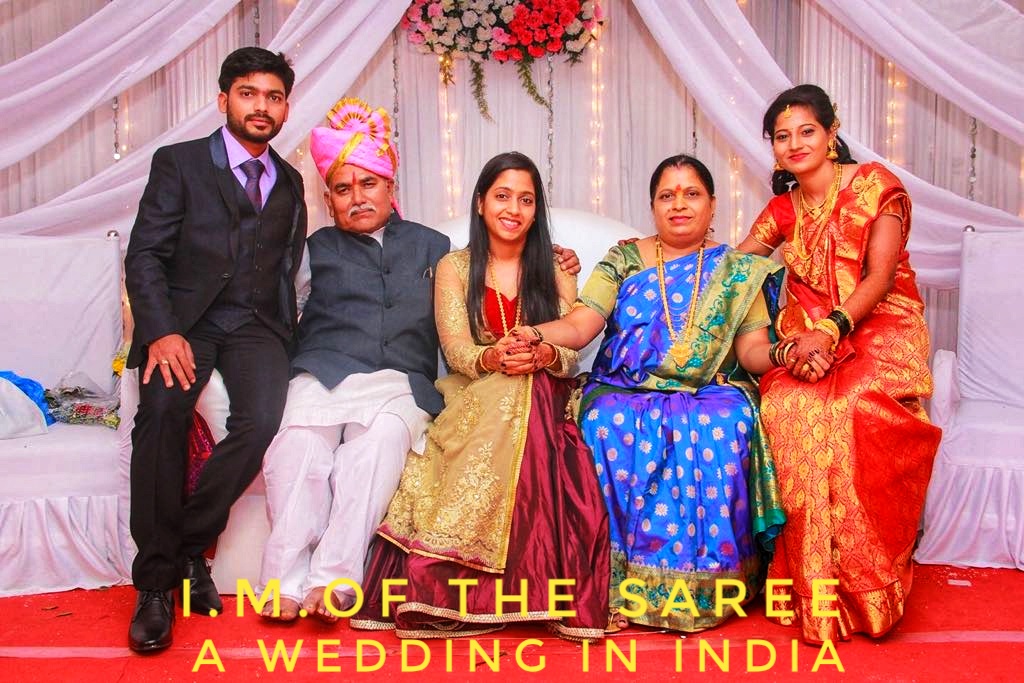
A daughter returns home from the USA to attend her brother’s wedding, Maharastra, India. Photo credit: International Museum of The Saree.
Vivaha, lagna and Kalyanam are familiar Sanskrit names for Hindu wedding ceremonies and Nikah is the name of a Muslim wedding ceremony. Other wedding customs and rituals are observed under religions such as, Islam, Janism, Bhuddism, Sikhism, Zorastrianism and Christianity that also exist in India. Christian wedding such as one in Kerala would typically include a western wedding gown for church and saree/lehengha for reception and the wedding would last one day. A pagri would be seen on a Sikh groom and the wedding would last up to three days, if desired.
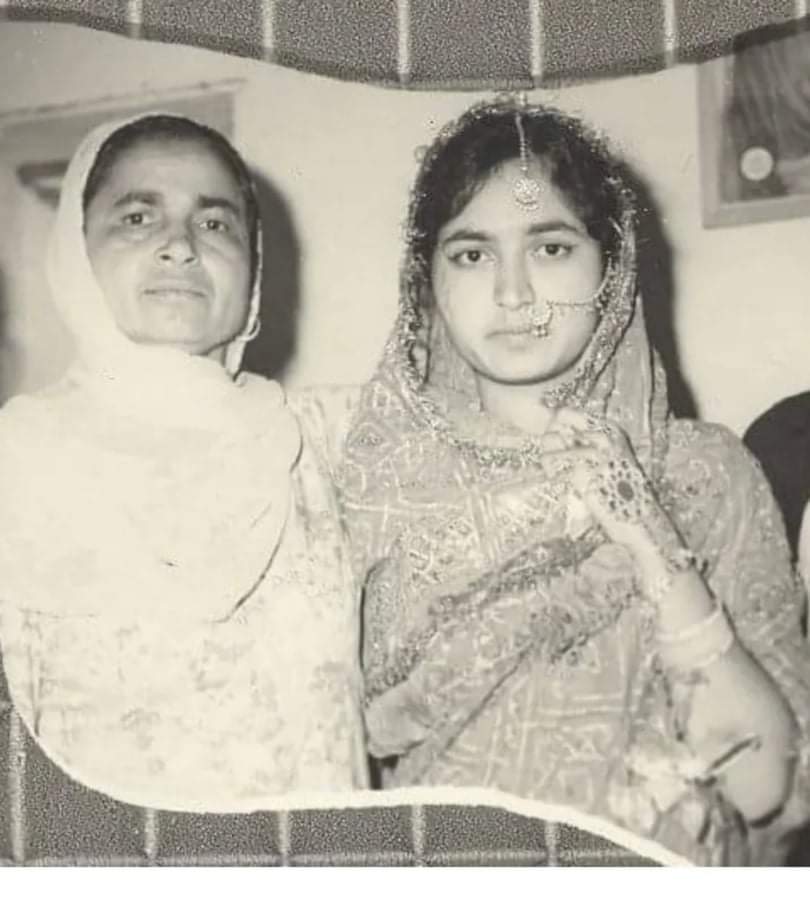
Sushil Kumari, featured bride (Dulhin) of 1974 in Punjab, India. She was arranged by her uncle to a diplomat (Dulhan) at the age of twenty four and married in a Sanatan Dharam Hindu ceremony. She wore a silk saree, adorned with gold jewelry on the forehead and hands often seen on Hindu brides. Her mother, Veeran Wali, wore a pink salwar kameez and dupatta. The saree was purchased by her mother. Photo credit: International Museum of The Saree.
Steps to Marriage: Although India’s weddings by majority have Hindu customs, regardless of religion with most traditional Indian marriages the bride and groom are arranged (match) and parents would have consented or been introduced unless it is deemed a love marriage from the beginning without arrangement. The groom traditionally asks for the hand of the bride and seeks the blessings of the family. An astrologer or guru/pandit is typically sought out to ensure that the fates of the couple are in alignment and arrangements begin to bring together the families of the bride and groom. With the major religion of India being Hinduism, the Haldi ceremony is noted in Indian wedding custom. This is where both the bride and groom are cleansed with turmeric paste and decadent henna is then placed on the bride’s body. Red tikka are customs for the Hindu brides on wedding day along with floral malas. Sangeets (singing) and dancing is customary in Indian weddings. Arja Samaj Hindu weddings typically have less rituals than a Sanatan wedding and the groom has different headwear. The weddings vary state by state with India’s vast geography, food and cultural make up, making an Indian wedding exciting if you’re a tourist who has just caught a glimpse of groom a top an elephant or exiting a car looking like a prince with his baraat (large procession) on way to the bride.
The bride traditionally moved from her parents’ home to the grooms home after marriage. Most Indian weddings last several days and are known to be large but there are exceptions with certain customs today due to economic means, smaller families and emergence of some cross-cultural households. Dowry, the gifting of money or material items from the bride’s family, has also been known as a traditional custom but mindful, dowry may or may not be enforced in every Indian marriage with current times.
To learn more visit FB/IG: International Museum Of The Saree.
by Marina Dedlovskaya

Unequal marriage by Vasiliy Pukirev (1862). Gallery Tretyakov, Moscow. Photo credit: Wikipedia/Commons.
Russian wedding traditions take their roots in the marriage ceremony of the Orthodox Church. It is one of the most beautiful and solemn rituals in all of Christianity. The bride wears a white decorated gown with a halo and veil; the groom dons a black evening coat. Everyone is happy! Or are they?...
In every social class of the Russian Empire, marriage was an arrangement between two families, often without the consent of the bride. The October Revolution of 1917 overthrew the tzarist regime and brought to Russia a new way of life, with new cultural traditions. One of the revolutionary leaders and architects of the new order, V.I. Lenin, declared that religion was "the opium of the masses”; as such, religion was banned from society — together with all associated ceremonies, including church marriage rites. Marriage was still recognized as a vital event in civil law and civil society, but no ceremony was required: just registration with the Act of Civil State Office.
Over time, however, the cast-off traditions began to reappear in new forms. In the Soviet Era, weddings once again came to be seen as defining events in the lives of young couples, and large celebrations were typically called for.
The bridal dress evolved in response to changing fashion and decorative trends, but the traditional snow — white color remained constant. Likewise, the groom remained attired in a traditional dark suit.
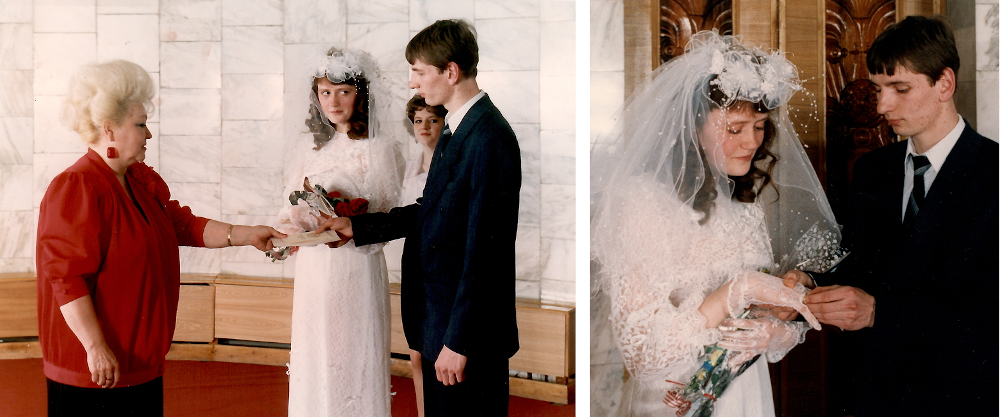
Roman and Olesya Senkovy at their wedding, the Act of Civil State of Novosibirsk, Russia , 1995. Photo source: Senkov's family photo archive.
The party in which these two served as “star players” typically lasted for two days and began with a tradition in which the bride had to be “ransomed” by the groom at her house. The bride would be “guarded” or hidden by her bridesmaids, who would refuse the groom’s offers of money and instead demand that he undergo certain challenges. For example, he might be expected to come up with 365 different sweetheart names for his future wife, one for each day of a year — or to choose the one that belongs to her from a dozen or so lip imprints made by the ladies of the wedding party. The best man assists the groom with these negotiations and tasks, but all the while the rest of the groomsmen try to find their way to the bride and “steal” her away for free! Thus, the “ransom” role play is always a source of great commotion and laughter!

Natalia and Vitaliy Simchenko with bridesmaids, Orenburg/Russia, 1986. Photo source: Marina Dedlovskaya's family photo archive.
The official part of the wedding ceremony, the part that results in recognition by the State, takes place at the Act of Civil State, where the couple signs the marriage certificate in the presence of two witnesses — typically the maid of honor and the best man. This is followed by a tour around the city and a photo session at sites memorable to couple.
The next stop is the wedding reception. The menu depends on family traditions and local specialties, so it can vary greatly. One thing, however, is present at every wedding: karavaj, an elaborately decorated round loaf of bread. The mother of the groom-now husband-offers it to the couple as a sign of welcome into her family.
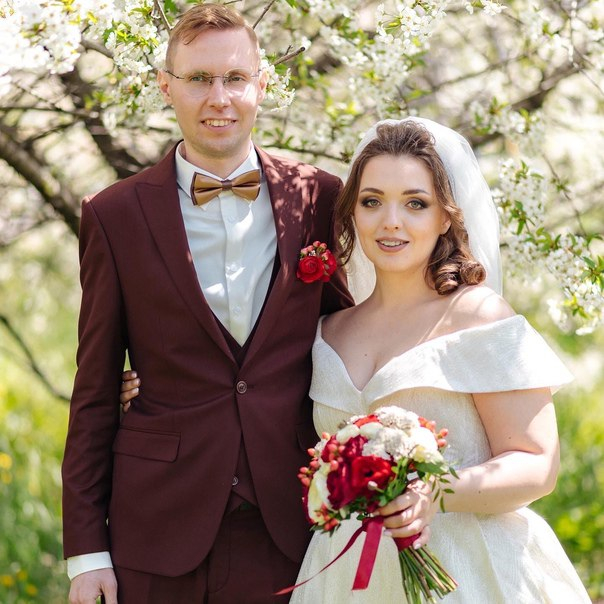
Natalia and Maxim Anisimovy, Krasnodar, 2021. Photo source: Marina Dedlovskaya's family photo archive.
In the 1990s, perestroika lifted the iron curtain and allowed western cultural traditions to find their way into Russia, even as the Soviet era was coming to a close. Since that time, weddings in Russia look almost indistinguishable from American or European weddings — except that the bride’s dress is invariably white, the “Ransom” is still enacted, and the karavaj is still eaten!
by Marta Kowalczyk and Malgorzata Marciniak
Weddings tend to be held only during 'good luck months' – those that contained the letter R in their Polish names such as March (marzec), June (czerwiec), August (sierpień), September (wrzesień), October (październik) and December (grudzień). In a country where so many people have at least some ties to the Catholic Church, many Polish wedding ceremonies are still held in churches. This remains an integral part of many couples' wedding plans. When the newlyweds exit the church, Polish guests shower them with grain/rice (or pennies) – is supposed to bring prosperity. After the ceremony, the reception starts when the newlyweds are greeted with bread and salt, followed by shots of vodka and water. The bread symbolizes that the couple would never go hungry, while the salt warned about life's difficulties. The shots – one filled with water, another with vodka – would determine who would rule the household. The glasses were then tossed and broken for good luck. Nowadays, the shots tend to be replaced with wine or champagne.
There are many other superstitions that still carry on today.
During the wedding party the guests taste traditional Polish meals and drinks, which may depend on local and family traditions. The most common soups are chicken broth or red beets soup. The meals may contain dumplings, baked meats, potatoes and salads. A big wedding cake is usually cut by the newly-wed couple and served to the guests. Guests will likely drink vodka but wine and beer are available as well. The dance of the new couple begins a dancing party which may last overnight. The entire celebrations may last even a few days and contain an aftermath (poprawiny) scheduled on the next day or next weekend.
by Hanqi Ye
Wedding traditions vary in different parts of China. In Wenzhou (a city in Zhejiang province), parents value engagement more than wedding since they control everything in engagement including betrothal gift negotiation. Based on their finical condition, Bridegroom's parents will give cash to bride’s parents, and bride's parents will buy a car or simply double the cash for this new family.
After engagement, bridegroom and bride start to take over. When preparing wedding dress, bridegroom needs to buy golden ornaments for bride, including earrings, bracelets, foot chains, necklaces, one pair of couples’ rings and a diamond ring. Bride is responsible for preparing bridegroom a wedding suit, two shirts, two ties, a pair of casual shoes and a pair of leather shoes, two sets of casual dress, socks, one bracelet and necklace. Besides, bride also need to prepare her own wedding dresses. Above tradition contains a secret of successful marriage, wife prepares husband daily dresses and husband buys her jewelry as reward.
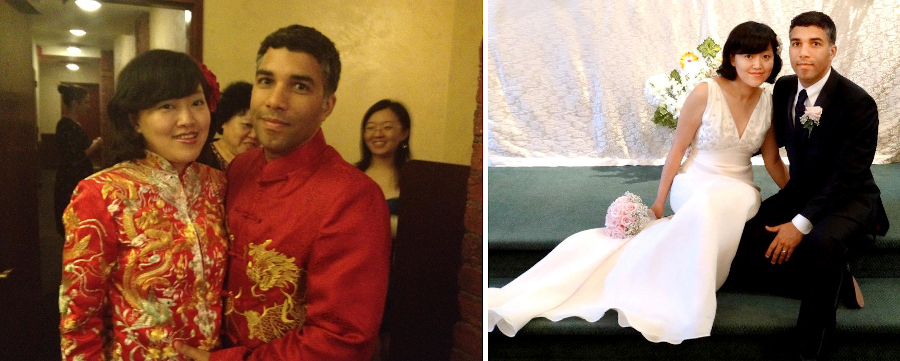
Dr. Na Xu at her wedding in traditinal and modern wedding dresses, Manhattan, NY, 2012. Photo source: Na Xu's family photo archive.
Usually, at least two sets of wedding clothes are prepared, traditional set (Left) will be used before wedding ceremony and modern set (Right) will be used during the ceremony.
In Wenzhou, wedding ceremony is more structured, so most distinctive tradition occurs before the ceremony. For example, when the wedding team arrives at the bride's house, three sound cannons will be fired, which notifies bridesmaids to lock up the door to bride's room. Groom will prepare red envelopes for each bridesmaid to open the door. Of course, some bridesmaids will give the groom hard challenges in order to get more red envelopes. In some places of Wenzhou, whoever comes across the wedding team will receive a red wedding egg. This custom is to share the new couple’s good luck to attendees.
by Habiba Boumlik
Like in other cultures, the Moroccan wedding involves social gathering, gift-giving, traditional dress, music, dance, and food. The wedding rituals represent a privileged moment where several rituals (rites of passage, rites of separation, rites of fertility, etc.) come into play. While there is no uniformity in celebrating a wedding, there are various core elements that are representative of a “Moroccan wedding.” Let me introduce you to some of them through the eyes of Fadwa and Omar who married recently. They met through mutual a friend, secretly dated for months before deciding to officialize their relationship. Their alliance conforms to the traditional conception of marriage: a family affair which is negotiated between the respective parents.
Marriage Proposal: During the first meeting that introduced both families through an intimate gathering of parents and adult siblings, Omar’s family formally asked for Fadwa’s hand. This ritualized moment underlines Fadwa and Omar’s conformity to parental and societal expectations in the matrimonial domain. During the second meeting, Omar and his parents came back with gifts for Fadwa (perfume, jewelry, clothing, flowers, chocolates, and pastries) to cement the alliance and seal a bond between these two individuals and their families. The third meeting was more official and involved more guests: the khutuba/engagement ceremony took place in the presence of two adul/notaries during which Fadwa and Omar signed the marriage contract. The wedding ceremony could now take place at the planned date. It started with weeks of preparation for this crucial day, a public celebration incorporating symbolic objects and practices.
Hammam Day: In the traditional neighborhood steam bath, Fadwa was treated like a queen by her friends, relatives, and neighbors. They scrubbed her body, washed her hair, cracked jokes, and sang. They could have gone to a more modern spa, but it would have been costlier and not as fun.
Henna Party: During this gathering of female friends and relatives, Fadwa wore a caftan (Moroccan dress) and a henna artist was hired to paint Fadwa’s hands and feet with intricate designs symbolizing fertility and blessings. The attendees danced and chanted. Omar was with his male friends. They received a dot of henna in their hand palm, listened to music, and waited for the big wedding party the next day. The bride and groom families decided to share the costs and celebrate the wedding in a banquet hall instead of using their private houses.
Ammaria/Display: While family and friends were gathering hours before they were able to see the bride, sipping on tea and juices, listening to live music and dancing, Fadwa was busy with her assistants (neggafa) getting her ready with hair styling, make up, dress, and accessories. Fadwa was finally “displayed” in a platform ammaria carried on the shoulders of 4 adults. Fadwa, the queen of the ceremony, was honored by being above the guests’ heads. Happy music and contagious rhythms were played to welcome the bride. Fadwa got out of the ammaria and set next to Omar after he was displayed too, wearing a white jabadour/male long embroidered coat. Over the ceremony, Fadwa changed into caftans/dresses three times, thus marking the highlight of the ceremony. Her last outfit was a white Western dress (instead of a white caftan) that she wore for the cake cutting ceremony. Omar wore his formal Western suit. Soon after, the newlyweds left the party on a car parade. Instead of going to the groom’s home where his mother would welcome them with milk and dates, they opted for a hotel to celebrate their first wedding night. They were followed by many cars from the wedding in a long celebratory procession, honking and shouting happily.
Ethnographic research reveals great local variety, as the rites practiced are multiple and are not uniform for all regions. For instance, in the families that identify as Amazigh/Berber, each step of these rituals is accompanied by tanggift songs, generally not associated with music or dancing. They are sung in turn by two groups of women, one speaking on behalf of the groom, the other on behalf of the bride.
Notwithstanding the great diversity of traditions and customs, the increasing urbanization has led to the generalization of some culinary, musical and sartorial practices. Dishes served during the wedding ceremony tend to be chicken with pickled lemon, lamb or beef with almonds and prunes, chicken or seafood bastila, a crispy large pie, bread, fruit and bubbly drinks, pastries and mint tea. Family who can afford it also serve a variety of appetizers and juices. And while there exists a rich repertoire of wedding songs, you could hear some hit-parades in most weddings throughout the country, performed by hired bands or by the guests. The wedding fashion has also experienced a growing tendency towards uniformization. The bride is adorned with outfits reflecting an influential region of Morocco (Fes, Souss, Tetouan...) stressing the amalgamation of various cultural practices. The borrowing and integration of foreign cultural elements (Indian, Yemeni, French) further delineates the cultural hybridization that has been intensified with migrations and social media.
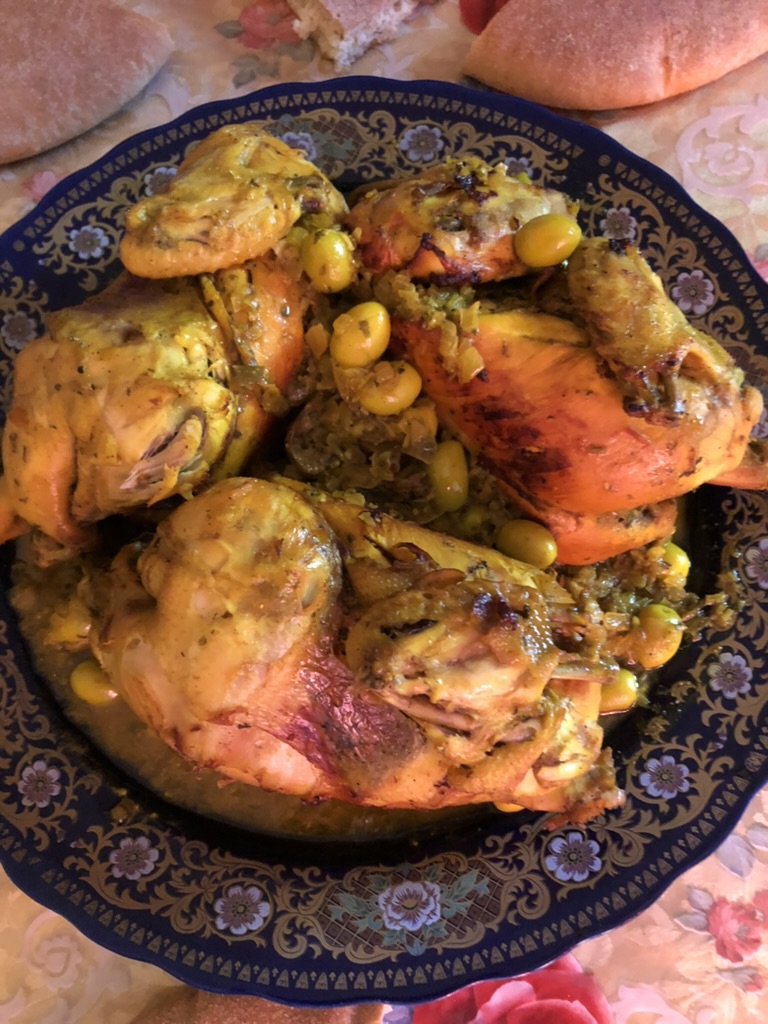
Stuffed chicken with olives and pickled lemons, a typical dish that is often served in weddings. Photo: Habiba Boumlik
Fadwa and Omar would like to ask you these questions: How did/will you get married? Could you imagine what someone might notice if they were anthropologists/strangers?
by Lucia Fuentes
Nebaj is a small town in the Cuchumatanes mountains of Guatemala and is the home to a community of Ixil Maya people. Over hundreds of years, the Ixil people have suffered violence and discrimination, from the early days of colonialism to the civil war of the 1980s. Some of their traditions have been lost, but the elaborate, hand-woven fabrics used to make blouses and skirts continue to be an important part of the goods produced by women weavers. The patterns of the weaved cloths differ from region to region, but the traditional wedding top, skirt and headdress from Nebaj are considered to be some of the most beautiful fabrics in Guatemala.
Throughout the country, local dishes combining ingredients used by Mayan people with some brought by the Spanish during colonial times, are unique and flavourful. One such dish is the “Caldo de Bodas” (wedding soup), made with smoked chicken, güisquil (a type of squash), squash leaves, corn, and other local vegetables.
In the photo, my cousin, who like the majority of Guatemalan’s is a “ladino” (mixed ancestry), can be seen wearing an elaborate and beautiful Nebaj traditional matrimonial top and headdress. The person beside her is my brother.
by Soheila Adl
Wedding traditions and customs vary from region to region in Iran and different ethnicities like Kurds, Azaries, Baluches, Persians, Lors and other ethnical groups add more verities to the wedding traditions. The factors of wealth, level of education and religious belief of families are important in adapting the nontraditional (western style of wedding) customs and blending them with the traditional ceremonies.
Men and woman are introduced to each other for marriage through dating or network of closed and extended family members, friends or neighbors. The next step is the official proposal by the man and his family through Khastegari which the groom (Damad) and his family do by going to the woman’s parents’ house to ask for permission and approval of bride’s (Aroos) family to marry their daughter. In majority of cases the woman has already accepted the proposal and the Khastegari is out of respect for the tradition and the families of groom and bride. In the Khastegari event, the groom and his family arrive at the bride’s house with flowers and in some occasions with one or several pieces of jewelry and the bride’s family welcomes them with offering tea, cakes, different pastries and fruits.
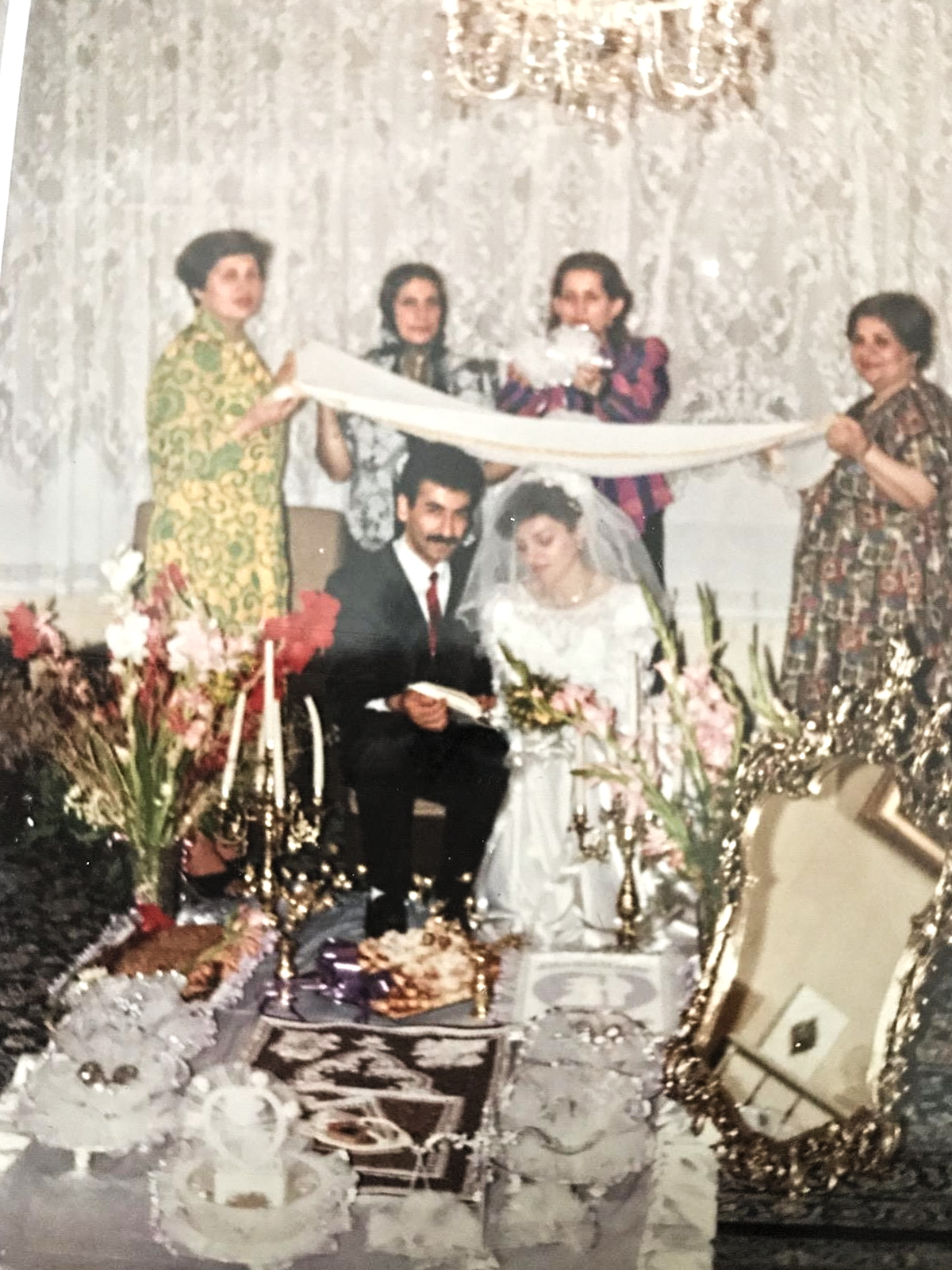
Maria Entezari and Mohammad Javdan at their wedding ceremony, Tehran, 1992. A shawl made out of silk is held over the bride and bridegroom's heads (who are sitting by the Sofreh). Two sugar cones made out of hardened sugar are used during the ceremony. These sugar cones are softly ground together above the bride and bridegroom's heads by a happily married female relative (Maria's mom and aunts) throughout the ceremony to shower them in sweetness. Photo source: Maria Entezari's personal photo archive.
If both families agree to the marriage and financial conditions of both side, the couple becomes engaged in a reasonably lavish party in few days or weeks. The engagement party is attended by the couple’s close family members and friends, in which the engagement rings are exchanged. These ring are usually simple, mainly gold with no stones.
Since the day of Khastegari, the couple’s families actively negotiate the financial aspect of marriage like the amount of Mehrieh (the money or value of properties that the groom has to give to the bride if they get divorced), Jahaz (dowry that bride buys and brings to the couple’s home after marriage), wedding expenses including rings, jewelry, clothing, number of guests to be invited and the wedding party cost. With prosperous families the finance issue is settled rather quickly. However families with not enough means may drag the negotiations for a while bargaining about how much should be paid and what should be included in the marriage contract. After sorting out the wedding finance, the wedding date is scheduled. Like most Western weddings, Iranian weddings are broken up into two parts - the Aghd (religious and marriage registration) and the Mehmooni (reception party). Traditionally, Iranian weddings would span several days (up to the 7 days) but in the modern age with busy life, most weddings now take place over the course of one day and in most instances the Aghd and Mehmooni are combined into the one ceremony.

Aghd ceremony. Photo source: https://www.iranchamber.com
The traditional wedding ceremony used to continues up to 7 days among Qashqai and Bakhtiari Nomads in Iran. The Aghd ceremony takes place in a specially decorated room with flowers and a beautiful and nicely decorated spread on the floor or on a Table called ‘Sofreh Aghd’. By custom the Aghd would normally take place at the bride’s home or her close relatives. Like in western weddings, the bride (Aroos) and groom (Dāmād) are situated before the guests, and the wedding vows and rings are exchanged and the official marriage contracts are signed. The Sofreh Aghd, contains several highly symbolic items (mirror and candle sticks, basket of colored eggs, bowl of gold coins, basket of fruit, burning Esfand incence, flowers, a cup rose water and a book of significance for the couple, usually Quran or Hafez poem book). Above the couple’s head is a canopy held by female family members that grind two sugar cones together so that the sugar granules fall into the canopy, symbolically showering the couple in sweetness. A special incense called Esfand, which is said in Persian tradition to ward off the evil eye is burned during the ceremony.
The reception party (Jashn Aroosi) that can takes place in the same day of Aghd or in the later time (from few days to several months) is a lavish feast with dancing, music and entertainers. The expense of reception is usually paid by the groom and his family or divided among the couple’s and their families. The traditional wedding dishes are usually khoresht gheimeh (meat stew with yellow spilt peas), shish kebob, grilled chicken, grilled lamb, shirin polo (white rice which is cooked with sugar), khoresht sabzi (meat stew with some herbs, polo (cooked white rice), bagheli polo with mahicheh (white rice mixed with fava beans, dill and pieces of meat), zeresh polo with morgh (cooked white rice with barbery, zafran and chicken).

Traditional wedding dishes. Photo source: https://fa.shafaqna.com
The bride’s wedding dress is white and the groom is dressed in suit. The wedding cake is cut by the couple through Knife dance (Raghseh Chaghoo). When the bride and groom are ready to cut the cake, they have to earn the knife which is in the hand of a female members of family that dance with it. The knife passes around among several females that each dance while holding it until is given to groom and bride to cut the cake.
The reception party is followed by more parties given by close relatives and friends for the next few weeks. These parties are called paghosah, meaning clearing the path for the newlywed couple. They are to introduce the two newly related families to each other.
by Asel Zhetigenova
The wedding traditions and ceremonies in Kyrgyzstan are significant and special, they took shape over several centuries and were subject to various Soviet and Western influences in the last century. Family stands among the highest priorities of the Kyrgyz people and marriages are meant to last for a lifetime.
When a man and a woman decide to marry, groom’s relatives should ask for permission to marry from the bride’s family and negotiate a bride price, which could include horses, cattle, boxes of chocolate, biscuits, and different alcoholic beverages. Besides, the “ransom” – “kalym” is then paid by the groom’s family to the bride’s parents. The sum of “kalym” varies in every region and depends on the wealth of the parents.

Photo source: Silkroadexplore.
Once everything is agreed upon, the grooms’ parents gift the bride with gold earrings as an official sign of engagement. After that, relatives from both sides exchange gifts (mostly clothes from head to toe).
Then, the groom’s side organize a wedding party. Most people prefer to organize a wedding party in a large restaurant by inviting a lot of guests.
On a wedding day, newlywed couple and their guests arrive at the Wedding House, where the registration of marriage is conducted. The groom usually wears a white or black “western style” suit, while the bride wears a western styled white wedding gown. At the Wedding House, the groom’s parents placed a big, white scarf on the fiancé head as a symbol of blessing.
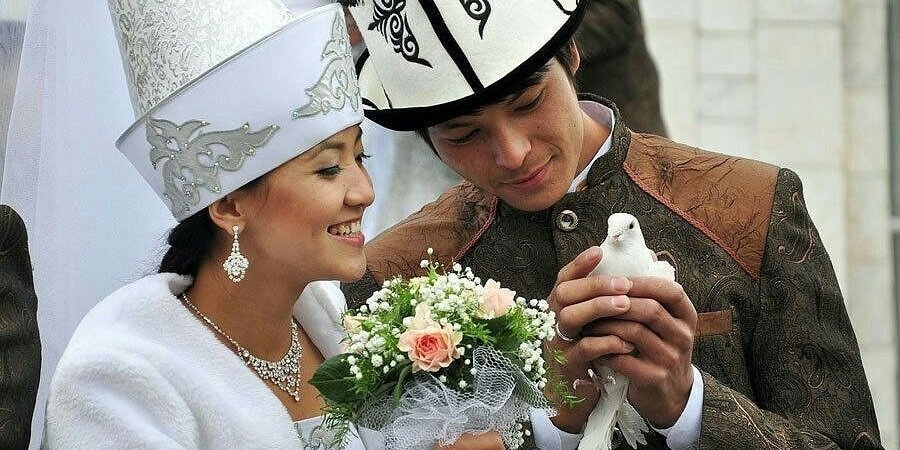
Photo source: Silkroadexplore.
After the registration, all guests go to the restaurant, where the celebration takes place. The celebration usually includes three parts with dancing breaks. Each section has its main food apart from other various appetizers, salads, fruits, and sweets.
The second part of the celebration takes place in the groom’s house. The ceremonies practiced are “kelin kirgizüü”, welcoming the bride to her new home; “sep jayuu”, displaying her dowry for people to see. Nowadays, the dowry includes new clothes, blankets, pillows, carpets, furniture, and home appliances.
One more interesting tradition related to a Kyrgyz wedding is “otko kirgizuu”, when the family of a girl need to invite their daughter with her husband and his parents to their house. Until that she can’t visit her parent’s house.
by Maureen Miller
The Claddagh ring is an old Irish tradition. The Claddagh ring is either passed down from one generation to the next or given by Irish men to their girlfriends. The ring represents love, friendship, and loyalties. Single girls wear the ring on their right hand with point of the heart facing the fingertip. When in a relationship, the ring is flipped to face the wrist, symbolizing that the heart has been captured and the lady is not available. When engaged to be married, the ring is switched to the left hand with the point of the heart facing the fingertip. Lastly, at the wedding the ring is flipped to face the wrist.
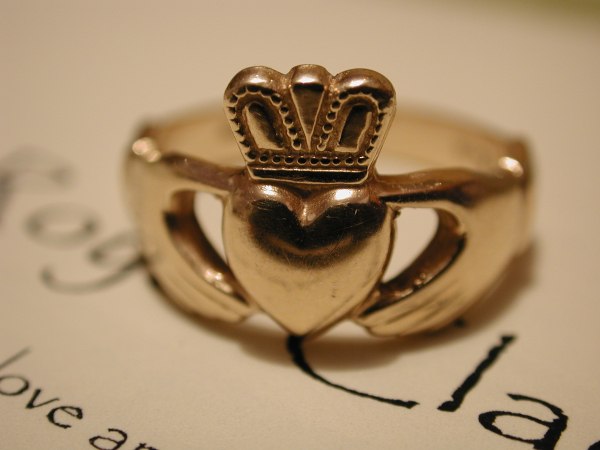
Claddagh ring. Photo source: Wikipedia.
A shamrock is a young sprig of clover which has become a symbol of Ireland. According to legends, St. Patrick used the shamrock to illustrate the doctrine of the Holy Trinity. This symbol is used throughout Irish weddings for good luck.
A horseshoe symbolizes good luck in many cultures. In Irish tradition, brides carried a horseshoe with them on their wedding day to bring good luck to the occasion and their marriage. Eventually, instead of an actual horseshoe brides started carrying a symbol of the horseshoe. According to the legends, the horseshoe should face up resembling a “U” so that the luck doesn't run out.
The phrase “Tie the knot” comes from an old Irish tradition. During Irish weddings, the hands of the bride and groom are literally tied together with a ribbon symbolizing their union.
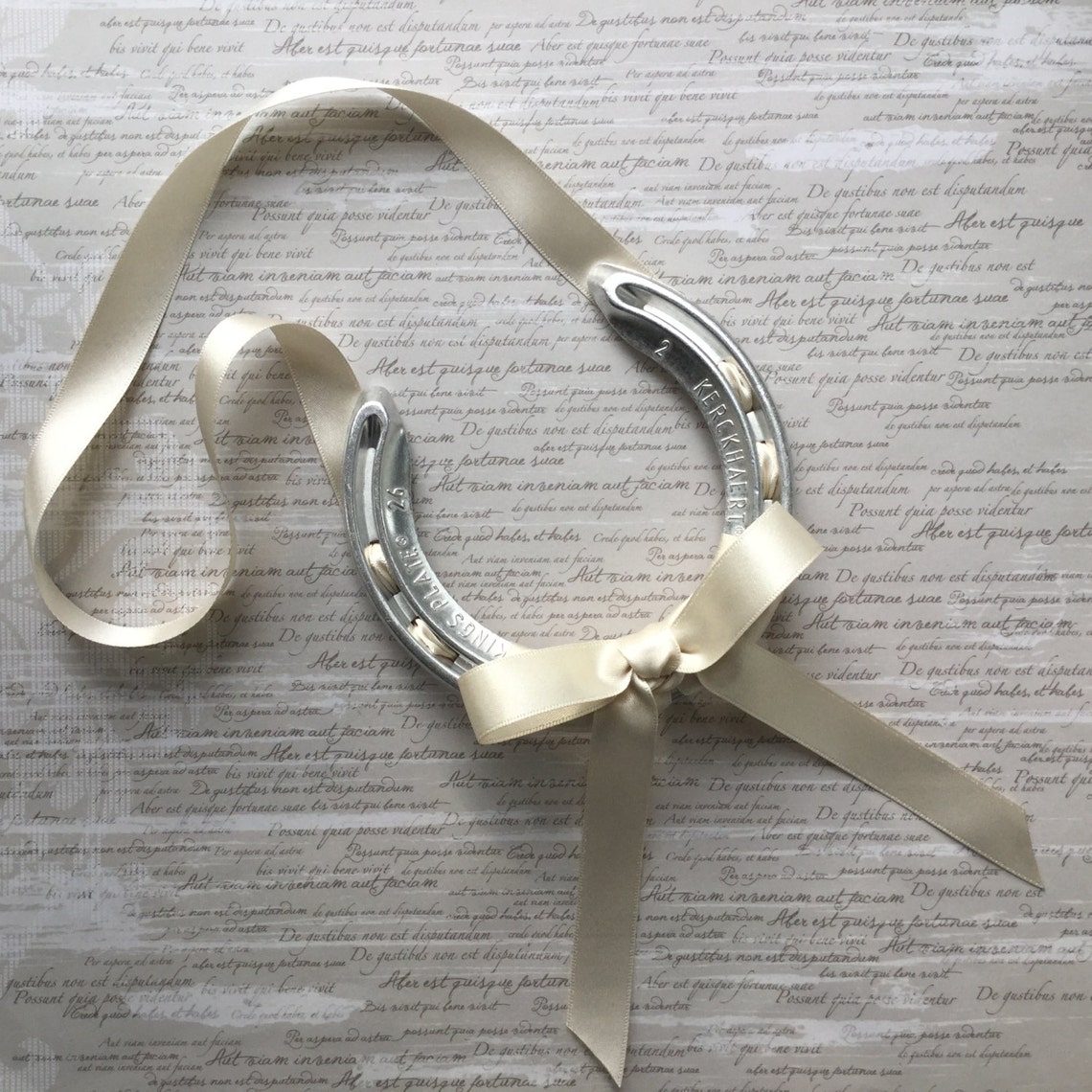
Wedding Horseshoe. Photo source: Etsy.
Wedding Dress: Although green is the color most associated with Ireland, Irish brides traditionally wore blue. White wedding gowns became popular with the British monarchs and have continued since. Irish lace is another traditional element. Many brides incorporated Irish lace into their wedding dress or veil. The traditional outfit for Irish grooms was the Irish kilt which is a plaid skirt.
Music: Bagpipers were the most popular wedding ceremony and reception music. The bride and groom were often piped throughout the wedding. The harp is another traditional Irish instrument that is incorporated in many weddings.
Bells are a traditional wedding gift for many Irish couples. This is an old superstition that said the sound of bells keep away the evil spirits. During the wedding ceremony, couples ring a bell together or provide their guests with bells to ring.
Cake: The traditional Irish cake is a fruitcake filled with almonds, raisins, cherries and spice and soaked in whiskey. And of course, Irish coffee is usually on the menu!
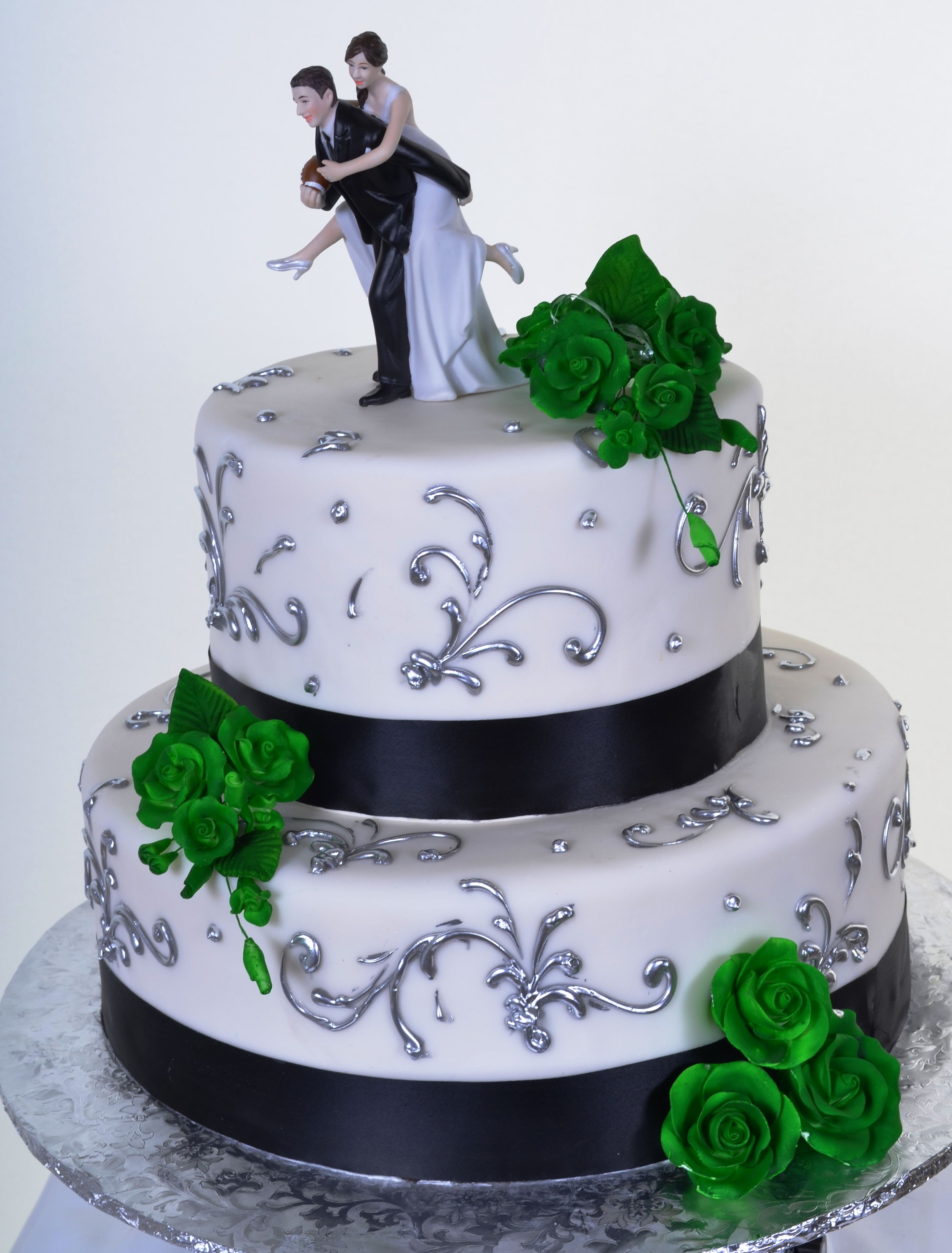
Irish Wedding Cake. Photo source: Cherrymarry.
Honeymoon: According to Irish tradition, after the wedding, the bride and groom were supplied with mead, a brew made of fermented honey, for them to share the unique brew for one full moon. In Irish this is referred to as the month of honey, “mi na meala”.
Irish Blessings: there are many old and beautiful Irish blessings and toasts recited at weddings. A Celtic Wedding might include the following blessing:
- May your mornings bring joy and your evenings bring peace.
- May your troubles grow few as your blessings increase.
- May the saddest day of your future
- Be no worse than the happiest day of your past.
- May your hands be forever clasped in friendship
- And your hearts joined forever in love.
- Your lives are very special,
- God has touched you in many ways.
- May his blessings rest upon you
- And fill all your coming days.
by Sherouk Alzeory
Egyptian weddings are known to be a never-ending festivity. The wedding party starts with a 'car parade' to alarm all locals that a bride and a groom are in town. The procession is usually lead by the newlyweds in a heavily embellished car imbued with flowers, followed by cars and motorcycle of family, friend and surprisingly local strangers as well. The unique aspect of this car parade is that all cars honk incessantly to create a synchronized celebratory melody until the arrival to the wedding venue. As the bride and groom enter the venue they are welcomed by a musical and dance group who perform “The Zaffa”. The Zaffa could be simply described as a wedding march in which musicians use instruments such as bendir, horns and bagpipes to play traditional melodies. The music invigorates traditional dancers with rhythm creating a celebratory atmosphere to welcome the bride and groom.
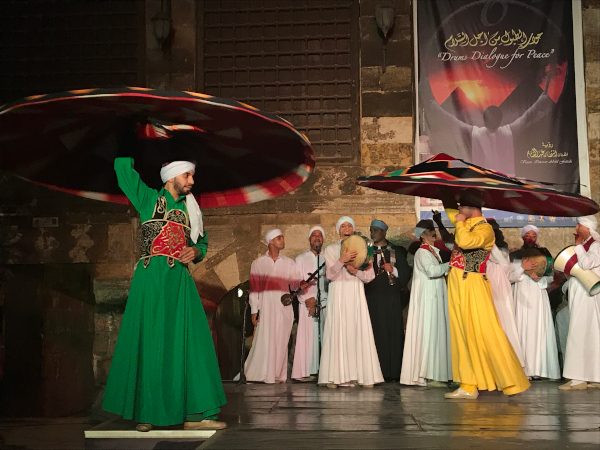
Whirling dervishes. Photo source: https://carriereedtravels.com/
Traditional Egyptian dancers include but are not limited to belly dancers, whirling dervishes and Saidi dances. As the bride in her white wedding dress and groom in his black suite enter their wedding reception, family and friends dance endlessly to music to keep the spirit of the party alive. Serving food, drinks and cake is an essential part of Egyptian weddings. Food is usually served in a buffet style with savory food that include various types of meat, poultry and traditional sweets dishes such baklava and Kunafa. Egyptian weddings are not for the faint of hearts with food, dance and festivities the wedding will last to the next day early morning, be ready to sacrifice your sleep for an unforgettable experience.

Kunāfah. Photo source: https://www.tasteatlas.com